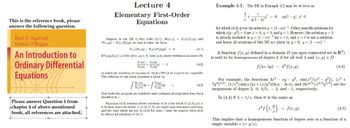
Algebra & Trigonometry with Analytic Geometry
13th Edition
ISBN: 9781133382119
Author: Swokowski
Publisher: Cengage
expand_more
expand_more
format_list_bulleted
Question

Transcribed Image Text:This is the reference book, please
answer the following question.
Ravi P. Agarwal
Donal O'Regan
An Introduction to
Ordinary Differential
Equations
Please answer Question 1 from
chapter 4 of above mentioned
book, all references are attached.
Lecture 4
Elementary First-Order
Equations
Suppose in the DE of first order (3.1). M(r,y) = X₁(r), (y) and
N()-X2()(), so that it takes the form
X()() | X()2(n) = 0.
(4.1)
If Y₁(y)X(r) 0 for all (r,y) e S, then (4.1) can be written as an exact DE
X₁(z) Y₂(v)
X2()()
+
= 0
(4.2)
in which the variables are separated. Such a DE (4.2) is said to be separable.
The solution of this exact equation is given by
-de +
Y₁(w)
(1.3)
Here both the integrals are indefinite and constants of integration have been
absorbed in c.
Equation (4.3) contains all the solutions of (4.1) for which Yi (2) X₂()
0. In fact, when we divide (1.1) by YX2 we might have lost some solutions,
and the ones which are not in (4.3) for some e must be coupled with (4.3)
to obtain all solutions of (4.1).
Example 4.1. The DE in Example 3.2 may be written as
1
1
= 0, ry(1-3) 0
y(1-y)
for which (4.3) gives the solution y = (1-er)-1. Other possible solutions for
which (-2)=0 are r = 0, y = 0, and y = 1. However, the solution y = 1
is already included in y= (1-cr) for c=0, and r=0 is not a solution,
and hence all solutions of this DE are given by y = 0, y = (1-cr).
A function f(x, y) defined in a domain D (an open connected set in IR²)
is said to be homogeneous of degree k if for all real A and (x, y) = D
f(x,y) = *(3)
(4.4)
For example, the functions 32-ry-y², sin(x²/(x²- y²)), (x² +
7y)1/5, (1/2) sin(x/y)+(x/y3)(Iny-Inz), and (6e//r2/31/3) are ho-
mogeneous of degree 2, 0, 4/5, -2, and -1, respectively.
In (4.4) if A 1/2, then it is the same as
f(x,y).
(4.5)
This implies that a homogeneous function of degree zero is a function of a
single variable v (=y/x).
Expert Solution
This question has been solved!
Explore an expertly crafted, step-by-step solution for a thorough understanding of key concepts.
Step by stepSolved in 2 steps

Knowledge Booster
Similar questions
- Repeat Example 5 when microphone A receives the sound 4 seconds before microphone B.arrow_forward/www.mathxl.com/Student/PlayerHomework.aspx?homeworkld=611416809&questionld=1&flushed%3false&cld%3D6709552¢erwin-yes MAT 234-KA: Elementary Differential Equations junior E Homework: Section 7.4 HW Score Question 4, 7.4.26 > points O Points Determine L{F}. 8s - 14s- Ss+7 F(s) = s (s - 7) %D Clear all View an example Get more help - Help me solve thisarrow_forwardPlease draw and make a short explanation about of this pmf : p(y) = 1/(y+1) for y = 0, 1, ..., 6.arrow_forward
- X 15.6.42 Use differentials to approximate the change in z for the given change in the independent variables. z= In (x'y) when (x.y) changes from (-2,2) to (-1,97,198) = Type an integer or a decimal.) Enter your answer in the answer box and then click Check Answer. Clear All All parts showingarrow_forwardCan someone help me solve this problem?arrow_forwardOnly do a, b and carrow_forward
- I am studying for a quiz and do not understand the substitution rule. can you help work the attached problem for me? If you can only help with one --- please explain the 3rd problem under "V. Substitution rule". Thank uou.arrow_forwardQuestion 13 What is r' (k) when k 3 and r(x) (2)6 Select the correct answer below: 618 (6ln 6+ 3) O 618 (2ln 6) O 18(67) O 618 (6ln 6 + 6) FEED A: S Content attributionarrow_forwardFind S e*dt This can not be done.arrow_forward
arrow_back_ios
SEE MORE QUESTIONS
arrow_forward_ios
Recommended textbooks for you
- Algebra & Trigonometry with Analytic GeometryAlgebraISBN:9781133382119Author:SwokowskiPublisher:Cengage
 Trigonometry (MindTap Course List)TrigonometryISBN:9781337278461Author:Ron LarsonPublisher:Cengage Learning
Trigonometry (MindTap Course List)TrigonometryISBN:9781337278461Author:Ron LarsonPublisher:Cengage Learning

Algebra & Trigonometry with Analytic Geometry
Algebra
ISBN:9781133382119
Author:Swokowski
Publisher:Cengage

Trigonometry (MindTap Course List)
Trigonometry
ISBN:9781337278461
Author:Ron Larson
Publisher:Cengage Learning